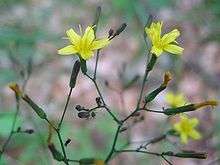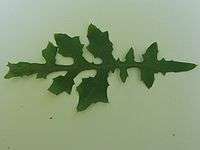Lactuca muralis
| Lactuca muralis | |
|---|---|
 | |
| Scientific classification | |
| Kingdom: | Plantae |
| Clade: | Angiosperms |
| Clade: | Eudicots |
| Clade: | Asterids |
| Order: | Asterales |
| Family: | Asteraceae |
| Genus: | Lactuca |
| Species: | L. muralis |
| Binomial name | |
| Lactuca muralis | |
| Synonyms[1] | |
| |
Lactuca muralis, the wall lettuce, is a perennial flowering plant of the genus Lactuca in the dandelion tribe within the daisy family, also referred to Mycelis muralis (L.) Dumort.[2][3]
Its chief characteristic is an open airy clumps of yellow flowers. Each "flower" is actually a composite flower, consisting of 4-5 petal-like flowers (strap or ray flowers), each approximately 5–7 mm (0.20–0.28 in) in length. There are no disc flowers. Lactuca muralis grows about 2–4 feet (0.6–1.2 m) tall with the lower leaves pinnately toothed and clasping.
Description

Lactuca muralis is slender, hairless herb[2] growing from 25 to 150 cm (10 to 59 in) tall. It often has purplish stems, and exudes a milky juice.
The lower leaves are lyre shaped, pinnate shaped. The lobes are triangular in shape the terminal lobe being the largest.[4] The upper leaves are stalkless, smaller and less lobed. All leaves are red tinged.[5]
The achenes are short beaked, spindle shaped and black. The pappus has simple white hairs,[2] the inner longer than the outer.
The flower heads are yellow, small with only 4-5 yellow ray florets.[6][2] 1 cm (1⁄2 in) wide more or less, on branches 90 degrees to the main stem, in loose panicle.[7] It flowers from June until September.[8]
Lactuca muralis is similar to Lactuca serriola L. and Lactuca virosa L. but clearly distinguished having only 5 florets.[9]
Taxonomy
The Latin specific epithet muralis is derived from the Latin word meaning 'growing on the wall'.[10]
Distribution and ecology
Lactuca muralis is a native of Europe but has invaded shady roadsides, paths and logged areas of the Pacific Northwest[11] and New England[12] It has become naturalized in parts of Northern Ireland as long ago as 1913.[13]
It can be found in woodlands, especially Beech.[7] It is also found in calcareous soils, and walls.
References
- ↑ "Mycelis muralis". Tropicos. Missouri Botanical Garden.
- 1 2 3 4 Parnell, J. and Curtis, T. 2012. Webb's An Irish Flora. Cork University Press. ISBN 978-185918-4783
- ↑ Altervista Flora Italiana, Lactuca muralis (L.) Gaertn. includes photos and European distribution map
- ↑ Clapham, A.R., Tutin, T.G. and Warburg, E.F. 1968 Excursion Flora of the British Isles Second Edition. ISBN 0-521-04656-4 Cambridge
- ↑ Blamey, Fitter, Fitter, Marjorie, Richard, Alistair (2003). Wild Flowers of Britain and Ireland. A & C Black - London. pp. 302–303. ISBN 0-7136-5944-0.
- ↑ Sterry, Paul (2006). Complete British Wild Flowers. HarperColins Publishers Ltd. pp. 212–213. ISBN 978-0-00-781484-8.
- 1 2 Webb, D.A., Parnell, J. and Doogue. D. 1996. An Irish Flora. Dundalgan Press (W. Tempest) Ltd. ISBN 0 85221 131 7
- ↑ Rose, Francis (1981). The Wild Flower Key. Frederick Warne & Co. pp. 390–391. ISBN 0-7232-2419-6.
- ↑ Martin, W.K.1965. The Concise British Flora in Colour Ebury Press
- ↑ Archibald William Smith A Gardener's Handbook of Plant Names: Their Meanings and Origins, p. 160, at Google Books
- ↑ Turner and Gustafson, Wildflowers of the Pacific Northwest.
- ↑ "Mycelis muralis (wall-lettuce)". Go Botany. New England Wildflower Society. Retrieved 2018-06-24. .
- ↑ Hackney, P. Ed. 1992. Stewart and Corry's Flora of the North-east of Ireland. Institute of Irish Studies and The Queen's University of Belfast. ISBN 0 85389 446 9(HB)
| Wikimedia Commons has media related to Mycelis muralis. |
| Wikispecies has information related to Lactuca muralis |